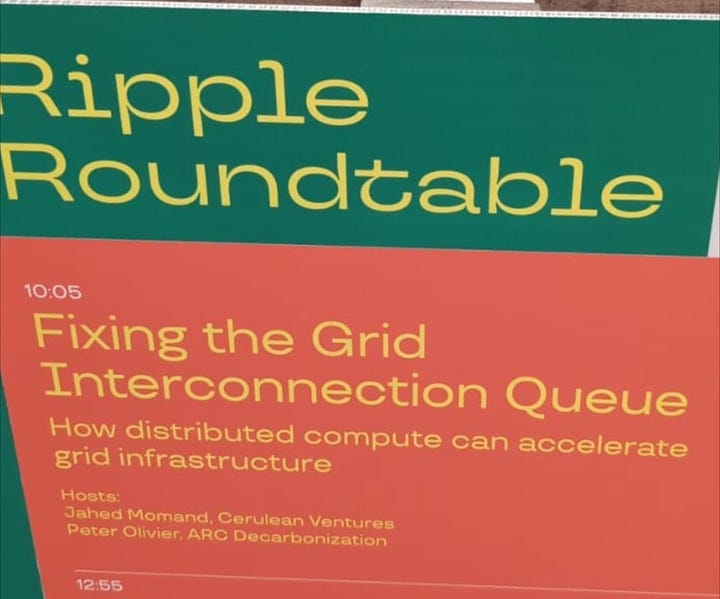The Obstacle is The Way: How AI is the Problem and (part of) the Solution to Decarbonization
Can distributed compute resources accelerate the energy transition?
This article is the outcome of a Ripple roundtable discussion from this year’s Drop in Malmö. Facilitated by Cerulean EIR and now portfolio founder Peter Olivier of Carrot, and myself (Jahed Momand), we brought together folks from across the climate ecosystem, but more specifically, the energy sector.


We had the privilege of leading this discussion with VCs investing in the grid (HV Capital, Energy Impact Partners, Generation IM, Speedinvest, and more), infrastructure and PE investors (Mobilize Climate, Junction Growth Investors), corporate VCs innovating on the grid (Honda, Hitachi, Mitsubishi, and more). What follows below is the framing we used for the discussion and the call for startups / innovation. Please let us know if you’re building in this space or just want to jam on it!
Great progress has been made in the name of clean energy over the past 25 years. It is indeed true that it’s becoming the cheapest form of energy available in many jurisdictions (though not all), that it might become too cheap to meter, that it may be more expedient to not even connect it to the grid.
However, therein lies the rub. If we want to meet many of the (very) ambitious goals for decarbonizing the economy and meeting climate goals, we have to find a way to connect cheap energy to demand (people who use it for things). As it stands, in the US we have 2 terrawatts (TW) of energy approved and waiting to break ground to be connected to the grid — this represents about 2x the current annual consumption of the United States. Ninety-five percent of that energy is renewable and hence largely decoupled from emissions.
Overview of the energy mix in the grid interconnection queue. This is what progress looks like! Except…
That’s huge!
If you dig a bit deeper though, you’ll see that new renewable energy projects greater than 200 MW take >55 months to get through the queue. To be extra clear, getting through the queue does not mean they are ready to be built - it simply means that they have the license to be connected! They can’t break ground! Usually, it takes another 3-5 years for the project to be completed. This means for us to get power on the grid at the scale necessary to meet the demands of AI and electrification, it can take upwards of 8-10 years from yesterday.
If we can’t connect this energy to the grid and make it accessible via utility-scale batteries yesterday, then we will inevitably build more LNG and coal plants to meet peak energy demand, as all grids are designed with peak energy demand in mind. Simply put, if we can’t meet (theoretical) peak energy demand, then we live with a world of rolling blackouts and lost productivity. Liquid natural gas and coal, given their emissions, are not the enemy - they serve a very specific, important purpose here! But it’s up to us to design around them, or they will become the default choice, along with their consequences.
So we already have a clogged grid queue, and it is becoming increasingly difficult to connect clean energy to consumers to decarbonize energy use. In the midst of this we also have massively growing energy demand from AI (and electrification).
Energy Demand, Driven by AI, is on a Collision Course With Climate Goals
Energy demand, after remaining flat for nearly two decades, is poised to radically grow. McKinsey and Company projects electricity demand from data centers will grow from 19 GW in 2023 to 32 GW in 2029, a 68% increase in demand.
Energy demand has been nearly flat since the 2000s. Until…
BCG says that US data centers currently use 2.5% of all domestic electricity, and it will triple to 7.5% by 2030. So we’re seeing that 1) energy demand has been flagging so it’s been unnecessary to build new power production capabilities and 2) all the while, data centers as a sector have been steadily growing their energy footprint and demands.
Many of the luminaries in the AI space are also picking up on this.
Sam Altman has said “An energy breakthrough is necessary for future artificial intelligence, which will consume vastly more power than people have expected,” at Davos 2024.
“Someone’s going to be better at this than anyone else, and multiple people are trying, and there is a race,” echoed Larry Ellison.
Everyone building in this space now realizes that energy is the one of the primary bottlenecks in the race for artificial general intelligence, and make no mistake about it, “there is a race.”
These factors are coming together in a way that gives AI demand a durability that climate goals do not have.
We’re already seeing the beginnings of the largest, most climate-friendly companies softening their goals. Microsoft’s emissions are up 29% since 2020, and 22% since 2022. Renewable energy projects take a lot longer to get off the ground than a data center (which we shall dig into shortly). Even though MSFT contracted nearly 20 GW of renewable electricity last year, its share of direct renewable energy decreased! Google’s emissions last year were 48% higher than their 2019 reported emissions. Meta’s emissions jumped 66% from 2021 to 2023.
This is usually where people start to sweat and form the words “regulation” in their mind. However, we simply don’t think anything substantial will be done with respect to regulation here, because AI has become a geopolitical arms race, with a short term time horizon. The Biden Administration recently announced a formal national security memo that will explore ways for the US to “preserve and expand advantages in AI”. There are the already-existing GPU export restrictions on NVidia and others for their Chinese customers. With the race for AI being central to state-based competition and geopolitics, there is very much an incentive to use more electricity, and we do not think it’s going away in the near term.
So Then, How do we Align Demand From AI With our Climate Goals?
It’s looking more and more like a two degree or more warming world is baked in at this point. What are our options? Do we just accept that the world’s image generators and project-manager webhook automations are going to raise the temperature, boil the oceans, and degrade lands globally?
Maybe the grid queue’s regulatory hurdles can be addressed — why does it take 28-55 months to get new renewables licensed for grid interconnection? Surely something can be done there, right?
In every instance in the US where NIMBY (not-in-my-neighborhood types who successfully legally fight new projects) goes up against Innovation™, NIMBY typically wins. Asking investors to take risk in the face of NIMBYs when they’ve been burnt repeatedly is a tall ask. Tech may not be able to solve this “inefficient” process.
The second thing people gravitate towards is subsidies - “let’s incentivize it”! There exist myriad subsidies for solar and wind, but none so far for the grid. The grid is a public good, with all of the issues (and benefits!) that comes along with being a public good. It will be very difficult to design an incentive that doesn’t step on the toes of e.g. large grid operators like PJM, the taxpayer, and energy demand.
However, we think there is an opportunity out there in plain sight — developing markets for intermittent renewable energy in the same way that markets were developed across the gig economy.
What Could This Hypothetical Market Look Like?
The last 20 years have seen the development of consumer and enterprise grade matching technology, fintech, and the dispatching across time and space of human demand and service supply. Airbnb, Zillow, Robinhood, SAP, Salesforce — the bits and pieces are all there. Before we get into the solution spaces, the path we took to get here already eliminates a few options. Let’s cover them.
Net new grid-connected renewables are out. Companies like Cloverleaf, headed by the former VP of Energy at Microsoft, are building co-located data centers with solar, batteries, and a grid tie. These will all be gated by the grid queue, and are also slow to build as we covered above. Even organizations that aren’t startups (Microsoft itself) can’t get these done quickly.
Stranded energy harvesting, by parking distributed computing resources to valorize a cheap energy source by location, are also out. Companies such as Crusoe Energy, Vespene Energy, and Lumen are operating data centers on capped natural gas wells, mitigating methane emissions. Or using domes to capture methane from pigs and cows (yes, really), and fully combusting the methane to carbon dioxide to drastically reduce its warming potential. Or capturing energy directly from the sun in space to perform computation. All of these provide green compute, but they don’t move the ball forward on grid infrastructure or decarbonization. Humans on earth remain competing with AI and paying high prices for energy, emitting more carbon dioxide when doing so.
On-site, on-demand compute that handles energy that is time-restrained. Usually done in the form of bitcoin mining, companies like Soluna and Rune Energy are doing this to harness grid-curtailed and / or inverter-clipped power. This requires an existing grid-tie (you have to be in well into the queue), it doesn’t improve the grid unless there is an agreement to end the offtake and eventually might be vulnerable to batteries as they smooth the duck curve.
Lastly, owner-operated power generation by tech companies is great, but will only exacerbate existing NIMBY issues. Imagine that yet another power plant gets built near you in Virginia. This time it’s nuclear but hey, the tech has come very far in ~70 years. Except this time, the power is only for [Oracle, Microsoft, Google], built on public land. This will probably attract regulation over time, and will be very unpopular as consumer energy prices continue to be unaddressed in the face of electrification.
So what remains?
We think any solution has to have some of the following features:
Pairing renewable project developers that are in the queue in the IA stage (see the first diagram above in this article) with demand for behind-the-meter electricity. In our example, we’d like to put AI, bitcoin mining, and anyone else who has a proven demand for paying almost any price for electricity, low and high, in this bucket.
Guaranteeing access to buyers for 3-5 years, at a fixed and below-market rate.
Developers would be able to accelerate their internal rate of return with lower energy prices, cycling investments into new renewable projects, grid operators would be able to plan and deploy infrastructure using existing, not potential, projects, as the demand would justify breaking ground on projects as they’re working through the queue.
Bundling offtakers in the off-chance that financing remains a challenge. Using the tools of finance, issue an advanced market commitment, loan guarantee, or revenue put to help establish the market.
What do you think? We’d love to hear what software, fintech, or other solutions you think we missed here. Leave a comment below, or find us on the internet.
Sources
Queued Up: Characteristics of Power Plants Seeking Transmission Interconnection. https://emp.lbl.gov/queues
Energy transition is happening. https://northskycapital.com/app/uploads/2024/04/Q1-2024-NSC-Market-Commentary.pdf
OpenAI CEO Altman says at Davos future AI depends on energy breakthrough. https://www.reuters.com/technology/openai-ceo-altman-says-davos-future-ai-depends-energy-breakthrough-2024-01-16/
What’s going on with Microsoft’s energy intensity? https://www.latitudemedia.com/news/microsoft-reveals-the-energy-impact-of-artificial-intelligence
Data Center Flexibility: A Call to Action. https://static1.squarespace.com/static/65e8fa08c461de679be90d0d/t/65ef4eadc4b8d53b84ccfd9e/1710182063168/SIP_Data+Center+Flexibility+-+A+Call+to+Action.pdf








